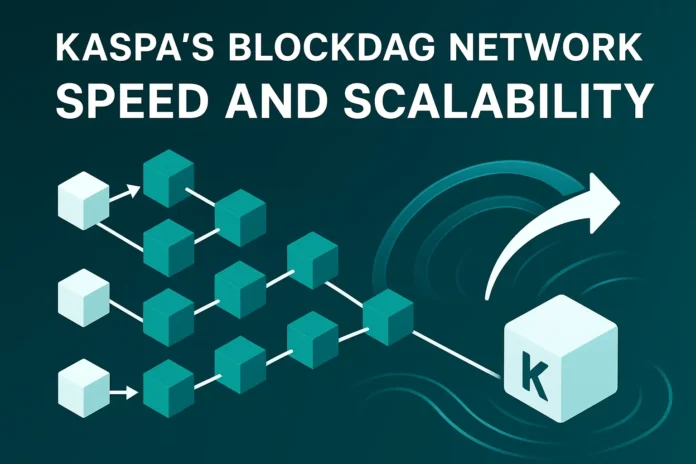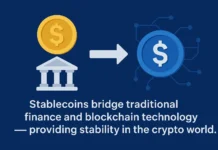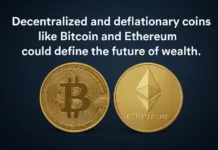In the rapidly advancing blockchain landscape, speed is emerging as one of the most critical factors for adoption and utility. While Bitcoin pioneered decentralized digital money and Ethereum unlocked the potential of smart contracts, new platforms are addressing the fundamental challenge of scalability. Among them, Kaspa stands out with its innovative BlockDAG architecture, which redefines how blockchains can operate at scale.
The Blockchain Bottleneck
Traditional blockchains such as Bitcoin and Ethereum use a linear chain of blocks, where each block is confirmed sequentially. This model provides strong security and immutability but introduces significant limitations:
- Low Throughput: Blockchains process fewer transactions per second (TPS) than centralized systems.
- High Latency: Confirmation times measured in minutes, not seconds.
- Scalability Issues: Difficulty handling surging transaction demand without compromising decentralization.
These constraints create a bottleneck that hinders blockchain from meeting the needs of global-scale financial systems, consumer applications, and enterprise use cases.
BlockDAG: A New Approach
Kaspa introduces BlockDAG (Directed Acyclic Graph) technology to overcome these limitations. Unlike linear blockchains, a BlockDAG enables the simultaneous creation and validation of multiple blocks. This parallelism addresses key performance challenges:
- High Throughput: Significantly higher TPS compared to traditional blockchains.
- Low Latency: Near-instant confirmation times.
- Scalability: The network can grow and handle increasing demand without sacrificing security or decentralization.
Kaspa sidesteps the bottleneck of sequential blockchains by enabling concurrent block confirmation while maintaining trustless security.
The Importance of Speed
Speed is not merely a convenience; it is a prerequisite for real-world adoption. Examples include:
- Payments: Instant settlement is crucial for everyday retail transactions and cross-border remittances.
- Decentralized Finance (DeFi): Faster confirmations improve liquidity, efficiency, and user experience.
- Gaming and NFTs: Applications that require real-time interaction depend on low-latency settlement.
Faster centralized alternatives can overshadow blockchain systems that lack adequate speed.
Kaspa’s Differentiators
Kaspa’s strengths go beyond its BlockDAG foundation:
- GPU-Friendly Mining: Ensures broader participation and reduces the risk of centralization.
- Fair Launch: No pre-mines or venture capital allocations, reinforcing decentralization and community ownership.
- Continuous Development: An active developer community focused on long-term innovation and ecosystem growth.
These principles align Kaspa with the ethos of open, decentralized systems while offering performance advantages that legacy chains struggle to match.
Looking Ahead
Although still in its early stages compared to Bitcoin and Ethereum, Kaspa’s trajectory is promising. If scalability and speed are indeed the final barriers to blockchain’s mainstream adoption, Kaspa’s BlockDAG architecture positions it as a leading candidate to bridge that gap.
Conclusion
Blockchain’s evolution depends not only on security and decentralization but also on scalable performance. Kaspa shows that it is possible to overcome the longstanding trade-offs of the blockchain trilemma. Kaspa advances blockchain infrastructure by combining decentralization, security, and speed through its BlockDAG technology.
Frequently Asked Questions (FAQs)
What is BlockDAG?
A BlockDAG (Directed Acyclic Graph) enables parallel creation and confirmation of blocks, in contrast to traditional blockchains that build blocks linearly.
How fast is Kaspa compared to Bitcoin and Ethereum?
Kaspa can confirm transactions in just seconds, whereas Bitcoin may take 10 minutes per block and Ethereum around 12–15 seconds. Kaspa’s throughput is also significantly higher.
Is Kaspa decentralized?
Kaspa launched through a fair distribution model with no pre-mine or venture capital allocations, and it supports GPU mining to promote decentralized participation.
Can Kaspa be mined?
Yes. Kaspa employs a Proof-of-Work (PoW) consensus mechanism optimized for GPUs, ensuring accessibility to a broad community of miners.
What are Kaspa’s use cases?
Kaspa’s speed and scalability make it suitable for payments, DeFi platforms, gaming, NFTs, and other applications that require fast and secure settlement.
How does Kaspa address the blockchain trilemma?
Kaspa’s BlockDAG architecture enables speed and scalability without compromising decentralization or security, offering a balanced solution to the trilemma.
Is Kaspa still in development?
Yes. Kaspa’s ecosystem is actively growing with continuous developer contributions, roadmap updates, and community-driven innovation.
- Kaspa vs. Bitcoin: Can BlockDAG Outpace the Original Blockchain?
- The 5 Fastest Decentralized Cryptocurrencies in the World
- Kaspa’s 10 Blocks Per Second: The Fastest Proof-of-Work Blockchain in History















